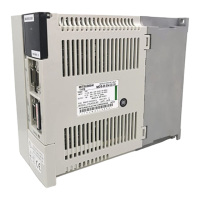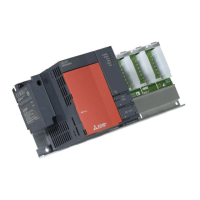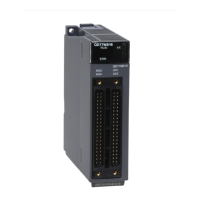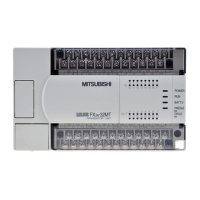Chapter 5 Adjustment
5-15
(4) Disturbance observer
The disturbance observer can reduce the effect caused by disturbance, frictional resistance or
torsion vibration during cutting by estimating the disturbance torque and compensating it. It also is
effective in suppressing the vibration caused by speed leading compensation control.
<Setting method>
1. Adjust VGN1 to the value where vibration does not occur, and then lower it 10 to 20%.
2. Set the load inertia scale (SV037:JL) with a percentage in respect to the motor inertia of the
total load inertia.
3. Set the observer filter band (observer pole) in the disturbance observer filter frequency
(SV043:OBS1), and estimate the high frequency disturbance to suppress the vibration. Set
300 as a standard.
4. Set the observer gain in disturbance observer gain (SV044:OBS2). The disturbance observer
will function here for the first time. Set 100 first, and if vibration does not occur, increase the
setting by 50 at a time to increase the observer effect.
5. If vibration occurs, lower OBS1 by 50 at a time. The vibration can be eliminated by lowering
OBS2, but the effect of the disturbance observer can be maintained by keeping OBS2 set to a
high value.
<Load inertia measurement method>
If the load inertia is not clearly known, estimate it with the following method.
1. With the unbalance axis, set the torque offset (SV032:TOF). (Refer to "5-3-4 (2) Unbalance
torque compensation")
2. Set JL = 100, OBS1 = 600, and OBS2 = 0, and carry out a return operation within the range
where the axis can operate smoothly. At this time, set the acceleration/deceleration time
constant so the acceleration/deceleration torque equals or exceeds (is 100% or higher than)
the stall (rated) torque.
3. Observe the estimated disturbance torque using the D/A output, and increase JL until the
disturbance torque during acceleration/deceleration becomes small (cannot be observed).
Even when the torque offset is set and JL is an appropriate value, the friction torque amount
remains in the estimated disturbance torque of axes having a large amount of friction. As
shown in the graphs below, judge the setting value for JL having only the friction torque
remaining as the machine load inertia magnification.
From software Version C3, the load inertia can be measured using the collision detection function. Refer to the section "5-5
Collision detection".
No. Abbrev. Parameter name Unit Explanation Setting range
SV037 JL Load inertia scale %
Set the load inertia that includes the motor in respect to the
motor inertia. (When the motor is a single unit, set 100%)
JL =
Jl + Jm
Jm
Jm : Motor inertia
Jl : Machine inertia
0 ~ 5000
SV043 OBS1 Disturbance
observer filter
frequency
rad/sec
Set the observer filter band (observer pole).
Set 300 as a standard, and lower the setting by 50 at a time if
vibration occurs.
0 ~ 1000
SV044 OBS2 Disturbance
observer gain
%
Set the observer gain.
Set 100 to 300 as a standard, and lower the setting if
vibration occurs.
0~ 1000
POINT
1. When the observer gain is set to zero (OBS2 = 0), the estimated
disturbance torque can be output to the D/A output even if the disturbance
observer is not functioning.
2. Parts of the machine that do not move smoothly can be presumed to be the
disturbance.
3. When the disturbance observer has been started, the lost motion
compensation must be readjusted.
Speed
command
Estimated
disturbance
torque
JL : Too low
Time
JL : Too high
Time
JL : Optimum
Time
Friction torque
0
0
0
0
0
0

